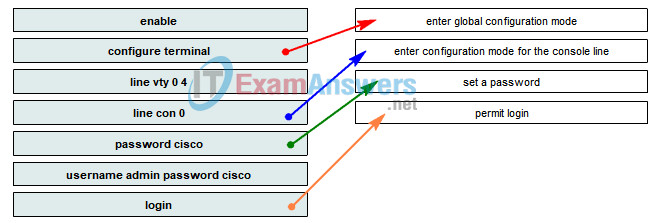1. Refer to the exhibit. What does the error message signify?

- A parameter is missing.
- The command was entered in the wrong CLI mode.
- The data of one of the parameters is incorrect.
- The command is ambiguous.
2. What is the effect of entering the banner login #Authorized Personnel Only!# command?
- #Authorized Personnel Only!# appears after the user logs in.
- Authorized Personnel Only! appears only when the user makes a Telnet connection.
- #Authorized Personnel Only!# appears only when the user enters global configuration mode.
- Authorized Personnel Only! appears before the username and password login prompts for any connection.
3. Drag the command on the left to the appropriate description on the right.
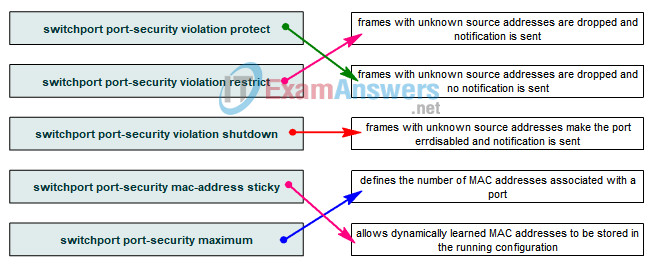
4. Refer to the exhibit. An Ethernet switch has developed the MAC address table shown in the exhibit. What action will the switch take when it receives the frame shown at the bottom of the exhibit?
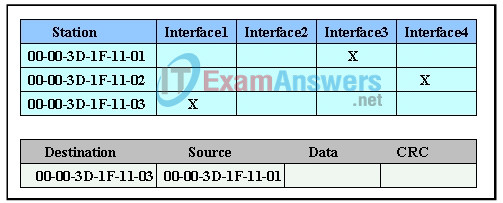
- forward the frame out all interfaces
- forward the frame out all interfaces except Interface3
- discard the frame
- forward the frame out Interface1
- forward the frame out Interface2
- forward the frame out Interface3
5. Refer to the exhibit. What can be determined from the command output?
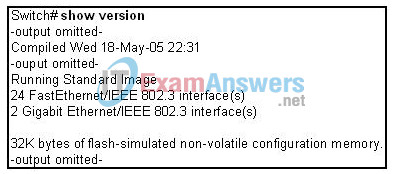
- The system has 32 KB of NVRAM.
- The switch has 24 physical ports.
- The system was last restarted on May 18, 2005.
- The Cisco IOS is a non-standard image.
6. What does pressing Ctrl-P on the command line do?
- begin context checking
- access symbolic translation
- access the command history buffer
- initiate command prompting
7. What advantage does SSH offer over Telnet when remotely connecting to a device?
- encryption
- more connection lines
- connection-oriented services
- username and password authentication
8. Refer to the exhibit. How many collision and broadcast domains are presented in the network?

- eight collision domains and two broadcast domains
- eight collision domains and three broadcast domains
- 11 collision domains and four broadcast domains
- 13 collision domains and two broadcast domains
9. Drag the term on the left to the appropriate description on the right.

10. Which three statements are true about the Carrier Sense Multiple Access with Collision Detection (CSMA/CD) technology? (Choose three.)
- In an Ethernet LAN domain, each station continuously listens for traffic on the medium to determine when gaps between frame transmissions occur and then sends the frame.
- In an Ethernet LAN domain, stations may begin transmitting any time they detect that the network is quiet (there is no traffic).
- In the CSMA/CD process, priorities are assigned to particular stations, and the station with the highest priority transmits frames on the medium.
- If a collision occurs in an Ethernet LAN domain, transmitting stations stop transmitting and wait a random length of time before attempting to retransmit the frame.
- If a collision occurs in an Ethernet LAN domain, only the station with the highest priority continues to transmit and the rest of the stations wait a random length of time before attempting to retransmit the frame.
- In an Ethernet LAN domain, all stations execute a backoff algorithm based on their assigned priorities before they transmit frames on the medium.
11. How does the Ethernet switch process the incoming traffic using port-based memory buffering?
- The frames are stored in queues that are linked to specific incoming ports.
- The frames are stored in queues that are linked to specific outgoing ports.
- The frames are transmitted to the outgoing port immediately.
- The frames are stored in queues that are linked to the common memory area.
12. What are two key features of an Ethernet switch with Layer 2 capabilities? (Choose two.)
- full-duplex operation
- broadcast and multicast traffic management
- security through access lists
- Layer 3 routing functions
- filtering based on MAC address
- network address translation (NAT)
13. The network administrator wants to configure an IP address on a Cisco switch. How does the network administrator assign the IP address?
- in privileged EXEC mode
- on the switch interface Fast Ethernet 0/0
- on the management VLAN
- on the physical interface connected to the router or next-hop device
14. Why should a default gateway be assigned to a switch?
- so that there can be remote connectivity to the switch via such programs as Telnet and ping
- so that frames can be sent through the switch to the router
- so that frames generated from workstations and destined for remote networks can pass to a higher level
- so that other networks can be accessed from the command prompt of the switch
15. Which two tasks does Auto-Negotiation in an Ethernet network accomplish? (Choose two.)
- sets the link speed
- sets IP address
- sets links duplex mode
- sets MAC address assignments on switch port
- sets the ring speed
16. What is the effect of entering the SW1(config-if)# duplex full command on a Fast Ethernet switch port?
- The connected device communicates in two directions, but only one direction at a time.
- The switch port returns to its default configuration.
- If the connected device is also set for full duplex, it participates in collision-free communication.
- The efficiency of this configuration is typically rated at 50 to 60 percent.
- The connected device should be configured as half duplex.
17. Which term describes the time delay between a frame being sent from a source device and received on a destination device?
- bandwidth
- latency
- attenuation
- Time-To-Live
- Frame Check Sum
18. Drag the command on the left to the correct description on the right.
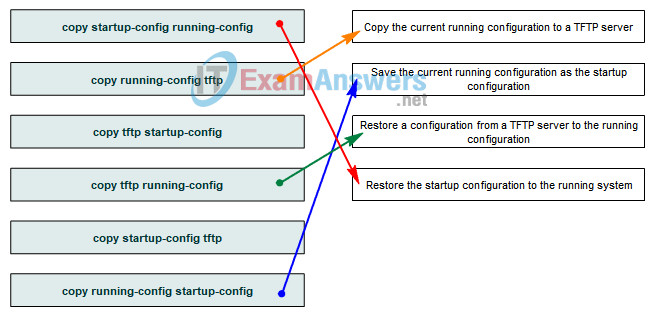
19. Drag the commands on the left to the associated description on the right to secure access to the console port on a switch. (Not all options are used.)
